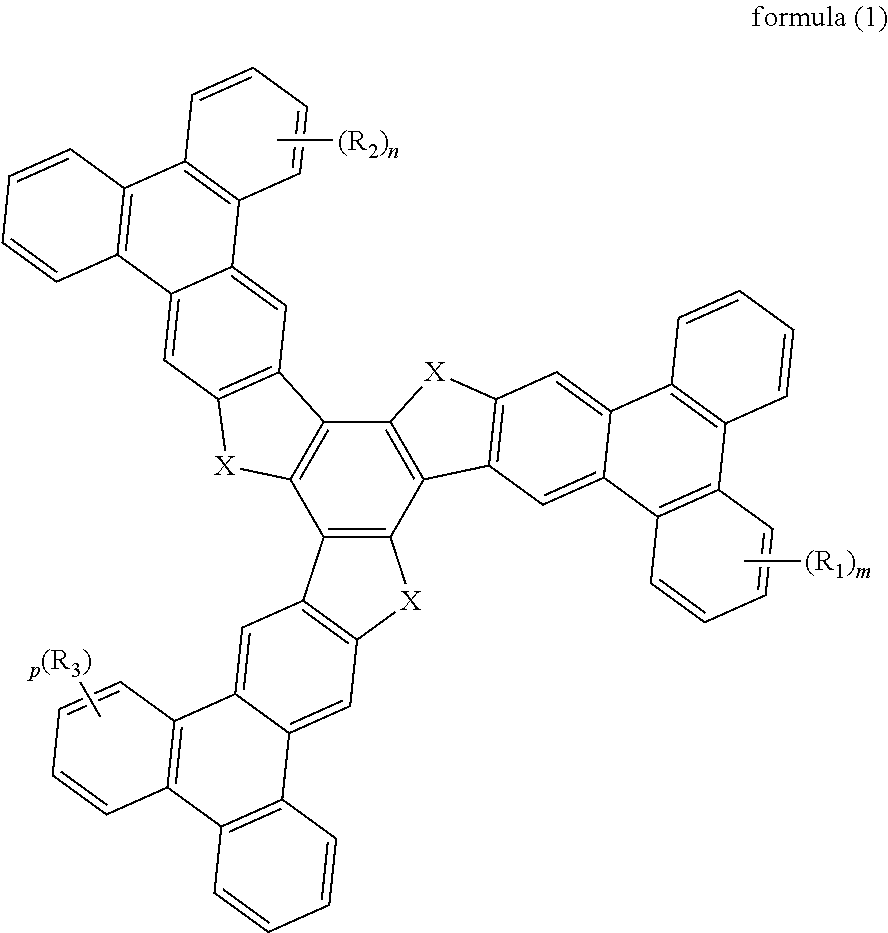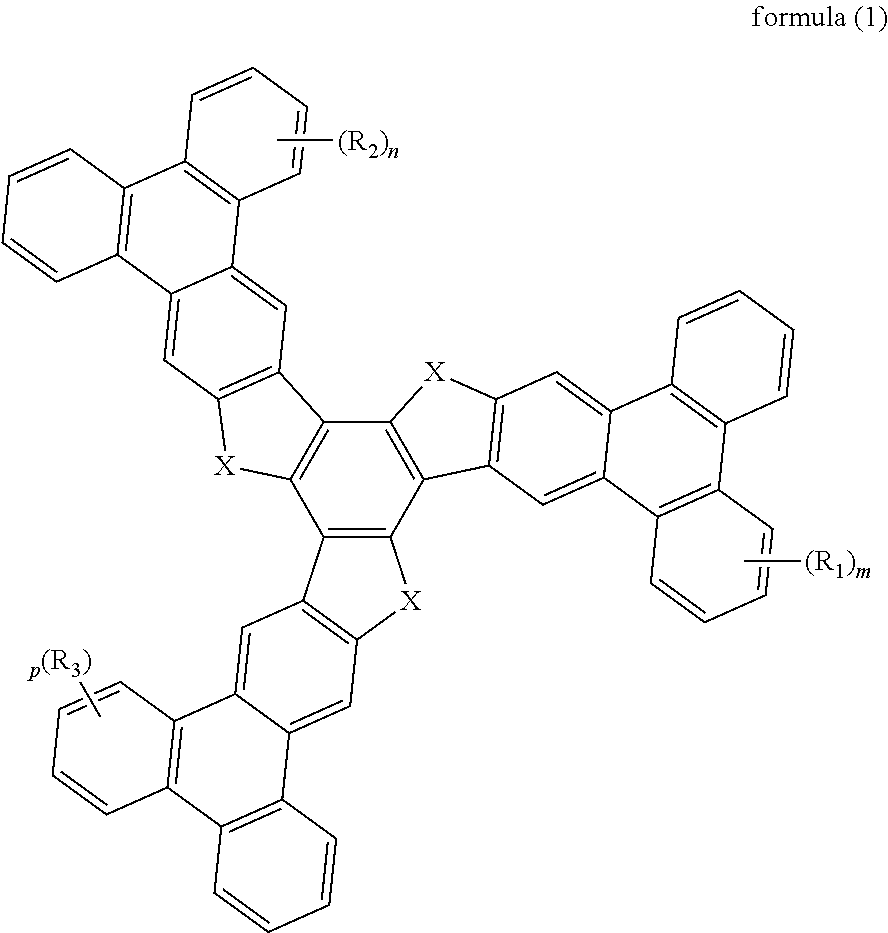Organic optoelectronic material and use thereof
- Summary
- Abstract
- Description
- Claims
- Application Information
AI Technical Summary
Benefits of technology
Problems solved by technology
Method used
Image
Examples
example 1
Synthesis of EX2
Synthesis of 5,5,10,10,15,15-hexamethyl-10,15-dihydro-5H-diindeno[1,2-a:1′,2′-c]fluorene
[0021]
[0022]150 ml of acetic acid anhydrous was dropwised slowly to a mixture of 28.7 g (21.7 mmol) of 1-indanone and 78 ml conc. HCl at ice-bath, then reflux overnight. After finishing the reaction, the mixture was allowed to cool to room temperature. The reaction was filtered to get the crude, the washed by water, acetone, dichloromethane to get compound as white solid (22.2 g, 15.6 mmol, 72%). 1H NMR (CDCl3, 400 MHz): chemical shift (ppm) 7.96 (d, 3H), 7.70 (d, 3H), 7.51 (t, 3H), 7.41 (t, 3H), 4.28 (s, 6H).
Synthesis of 3,8,13-tribromo-5,5,10,10,15,15-hexamethyl-10, 15-dihydro-5H-diindeno[1,2-a:1′,2′-c]fluorene
[0023]
[0024]3.92 g (24.5 mmol) of bromine was dropwised slowly to a mixture of 3 g (7.0 mmol) of 5,5,10,10,15,15-hexamethyl-10,15-dihydro-5H-diindeno [1,2-a:1′,2′-c]fluorene and 150 ml dichloromethane at ice-bath, then stir at room temperature for 12 h. After finishing the...
example 2
Synthesis of EX14
Synthesis of 5,10,15-tribenzyl-3,8,13-tribromo-10,15-dihydro-5H-diindolo[3,2-a:3′,2′-c]carbazole
[0029]
[0030]2.86 g (16.09 mmol) of N-Bromosuccinimide was added to a mixture of 3 g (4.87 mmol) of 5,10,15-tribenzyl-10,15-dihydro-5H-diindolo [3,2-a:3′,2′-c]carbazole (J. Mater. Chem. A, 2013, 1, 4077) and 300 ml DMF at dark, and then slowly heated until 60° C., then keep for 12 h. After finishing the reaction, the mixture was allowed to cool to room temperature and poured into ice-water, then filtered to get the crude (3.2 g, 3.79 mmol, 78%) as a pale brown solid, used in next step without purification. 1H NMR(CDCl3, 400 MHz): chemical shift (ppm) 8.02 (m, 3H), 7.76 (s, 3H), 7.47˜7.11 (m, 15H), 6.01 (s, 6H).
Synthesis of 5,10,15-tribenzyl-3,8,13-tri(biphenyl-2-yl)-10,15-dihydro-5H-diindolo[3,2-a:3′,2′-c]carbazole
[0031]
[0032]A mixture of 3.2 g (3.75 mmol) of 5,10,15-tribenzyl-3,8,13-tribromo-10,15-dihydro-5H-diindolo[3,2-a:3′,2′-c]carbazole, 3.34 g (16.90 mmol) of bipheny...
example 3
Synthesis of EX18
Synthesis of 2,7,12-tribromo-benzo[1,2-b:3,4-b′:5,6-b″]tris [1]benzothiophene
[0035]
[0036]Benzo[1,2-b:3,4-b′:5,6-b″]tris[1]benzothiophene (The prepared method from Tetrahedron, 42(2), 763-73; 1986) instead of 5,5,10,10,15,15-hexamethyl-10,15-dihydro-5H-diindeno[1,2-a:1′,2′-c]fluorene, except for using the same method as in synthesis Example 1, the desired compound of 2,7,12-tribromo-benzo[1,2-b:3,4-b′:5,6-b″]tris[1]benzothiophene (yield=52%) was obtained. MS (m / z, FD+):629.9
Synthesis of 2,7,12-tri(5-octyl biphenyl-2-yl)-benzo[1,2-b:3,4-b′: 5,6-b″]tris[1]benzothiophene
[0037]
[0038]2,7,12-tribromo-benzo[1,2-b:3,4-b′:5,6-b″]tris[1]benzothiophene instead of 3,8,13-tribromo-5,5,10,10,15,15-hexamethyl-10,15-dihydro-5H-diindeno[1,2-a:1′,2′-c]fluorene and 5-octylbiphenyl-2-ylboronic acid instead of biphenyl-2-ylboronic acid, except for using the same method as in synthesis Example 1, the desired compound of 2,7,12-tri(5-octyl biphenyl-2-yl)-benzo [1,2-b:3,4-b′:5,6-b″]tris[1]b...
PUM
| Property | Measurement | Unit |
|---|---|---|
| Fraction | aaaaa | aaaaa |
| Fraction | aaaaa | aaaaa |
| Fraction | aaaaa | aaaaa |
Abstract
Description
Claims
Application Information
 Login to View More
Login to View More - R&D
- Intellectual Property
- Life Sciences
- Materials
- Tech Scout
- Unparalleled Data Quality
- Higher Quality Content
- 60% Fewer Hallucinations
Browse by: Latest US Patents, China's latest patents, Technical Efficacy Thesaurus, Application Domain, Technology Topic, Popular Technical Reports.
© 2025 PatSnap. All rights reserved.Legal|Privacy policy|Modern Slavery Act Transparency Statement|Sitemap|About US| Contact US: help@patsnap.com



